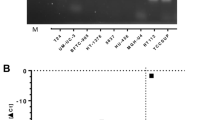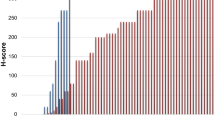Abstract
Purpose
To investigate the prognostic role of expression of urokinase-type plasminogen activator system members, such as urokinase-type activator (uPA), uPA-receptor (uPAR), and plasminogen activator inhibitor-1 (PAI-1), in patients treated with radical prostatectomy (RP) for prostate cancer (PCa).
Methods
Immunohistochemical staining for uPA system was performed on a tissue microarray of specimens from 3121 patients who underwent RP. Cox regression analyses were performed to investigate the association of overexpression of these markers alone or in combination with biochemical recurrence (BCR). Decision curve analysis was used to assess the clinical impact of these markers.
Results
uPA, uPAR, and PAI-1 were overexpressed in 1012 (32.4%), 1271 (40.7%), and 1311 (42%) patients, respectively. uPA overexpression was associated with all clinicopathologic characteristics of biologically aggressive PCa. On multivariable analysis, uPA, uPAR, and PAI-1 overexpression were all three associated with BCR (HR: 1.75, p < 0.01, HR: 1.22, p = 0.01 and HR: 1.20, p = 0.03, respectively). Moreover, the probability of BCR increased incrementally with increasing cumulative number of overexpressed markers. Decision curve analysis showed that addition of uPA, uPAR, and PAI-1 resulted in a net benefit compared to a base model comparing standard clinicopathologic features across the entire threshold probability range. In subgroup analyses, overexpression of all three markers remained associated with BCR in patients with favorable pathologic characteristics.
Conclusion
Overexpression of uPA, uPAR, and PAI-1 in PCa tissue were each associated with worse BCR. Additionally, overexpression of all three markers is informative even in patients with favorable pathologic characteristics potentially helping clinical decision-making regarding adjuvant therapy and/or intensified follow-up.




Similar content being viewed by others
References
Siegel RL, Miller KD, Jemal A (2018) Cancer statistics, 2018. CA Cancer J Clin 68(1):7–30. https://doi.org/10.3322/caac.21442
Mottet N, Bellmunt J, Bolla M, Briers E, Cumberbatch MG, De Santis M, Fossati N, Gross T, Henry AM, Joniau S, Lam TB, Mason MD, Matveev VB, Moldovan PC, van den Bergh RCN, Van den Broeck T, van der Poel HG, van der Kwast TH, Rouviere O, Schoots IG, Wiegel T, Cornford P (2017) EAU-ESTRO-SIOG guidelines on prostate cancer. Part 1: Screening, diagnosis, and local treatment with curative intent. Eur Urol 71(4):618–629. https://doi.org/10.1016/j.eururo.2016.08.003
Gallina A, Chun FK, Suardi N, Eastham JA, Perrotte P, Graefen M, Hutterer G, Huland H, Klein EA, Reuther A, Montorsi F, Briganti A, Shariat SF, Roehrborn CG, de la Taille A, Salomon L, Karakiewicz PI (2008) Comparison of stage migration patterns between Europe and the USA: an analysis of 11 350 men treated with radical prostatectomy for prostate cancer. BJU Int 101(12):1513–1518. https://doi.org/10.1111/j.1464-410X.2008.07519.x
Cornford P, Bellmunt J, Bolla M, Briers E, De Santis M, Gross T, Henry AM, Joniau S, Lam TB, Mason MD, van der Poel HG, van der Kwast TH, Rouviere O, Wiegel T, Mottet N (2017) EAU-ESTRO-SIOG guidelines on prostate cancer. Part II: treatment of relapsing, metastatic, and castration-resistant prostate cancer. Eur Urol 71(4):630–642. https://doi.org/10.1016/j.eururo.2016.08.002
Pound CR, Partin AW, Eisenberger MA, Chan DW, Pearson JD, Walsh PC (1999) Natural history of progression after PSA elevation following radical prostatectomy. JAMA 281(17):1591–1597
Lughezzani G, Briganti A, Karakiewicz PI, Kattan MW, Montorsi F, Shariat SF, Vickers AJ (2010) Predictive and prognostic models in radical prostatectomy candidates: a critical analysis of the literature. Eur Urol 58(5):687–700. https://doi.org/10.1016/j.eururo.2010.07.034
Shariat SF, Kattan MW, Vickers AJ, Karakiewicz PI, Scardino PT (2009) Critical review of prostate cancer predictive tools. Future Oncol (London, England) 5(10):1555–1584. https://doi.org/10.2217/fon.09.121
Shariat SF, Semjonow A, Lilja H, Savage C, Vickers AJ, Bjartell A (2011) Tumor markers in prostate cancer I: blood-based markers. Acta Oncol (Stockholm, Sweden) 50(Suppl 1):61–75. https://doi.org/10.3109/0284186x.2010.542174
Singh H, Canto EI, Shariat SF, Kadmon D, Miles BJ, Wheeler TM, Slawin KM (2004) Improved detection of clinically significant, curable prostate cancer with systematic 12-core biopsy. J Urol 171(3):1089–1092. https://doi.org/10.1097/01.ju.0000112763.74119.d4
Mekkawy AH, Pourgholami MH, Morris DL (2014) Involvement of urokinase-type plasminogen activator system in cancer: an overview. Med Res Rev 34(5):918–956. https://doi.org/10.1002/med.21308
Halamkova J, Kiss I, Pavlovsky Z, Jarkovsky J, Tomasek J, Tucek S, Hanakova L, Moulis M, Cech Z, Zavrelova J, Penka M (2011) Clinical relevance of uPA, uPAR, PAI 1 and PAI 2 tissue expression and plasma PAI 1 level in colorectal carcinoma patients. Hepatogastroenterology 58(112):1918–1925. https://doi.org/10.5754/hge10232
Look MP, van Putten WL, Duffy MJ, Harbeck N, Christensen IJ, Thomssen C, Kates R, Spyratos F, Ferno M, Eppenberger-Castori S, Sweep CG, Ulm K, Peyrat JP, Martin PM, Magdelenat H, Brunner N, Duggan C, Lisboa BW, Bendahl PO, Quillien V, Daver A, Ricolleau G, Meijer-van Gelder ME, Manders P, Fiets WE, Blankenstein MA, Broet P, Romain S, Daxenbichler G, Windbichler G, Cufer T, Borstnar S, Kueng W, Beex LV, Klijn JG, O'Higgins N, Eppenberger U, Janicke F, Schmitt M, Foekens JA (2002) Pooled analysis of prognostic impact of urokinase-type plasminogen activator and its inhibitor PAI-1 in 8377 breast cancer patients. J Natl Cancer Inst 94(2):116–128
Nakanishi K, Kawai T, Torikata C, Aurues T, Ikeda T (1998) Urokinase-type plasminogen activator, its inhibitor, and its receptor in patients with upper urinary tract carcinoma. Cancer 82(4):724–732
Janicke F, Prechtl A, Thomssen C, Harbeck N, Meisner C, Untch M, Sweep CG, Selbmann HK, Graeff H, Schmitt M (2001) Randomized adjuvant chemotherapy trial in high-risk, lymph node-negative breast cancer patients identified by urokinase-type plasminogen activator and plasminogen activator inhibitor type 1. J Natl Cancer Inst 93(12):913–920
Shariat SF, Roehrborn CG, McConnell JD, Park S, Alam N, Wheeler TM, Slawin KM (2007) Association of the circulating levels of the urokinase system of plasminogen activation with the presence of prostate cancer and invasion, progression, and metastasis. J Clin Oncol Off J Am Soc Clin Oncol 25(4):349–355. https://doi.org/10.1200/jco.2006.05.6853
Gupta A, Lotan Y, Ashfaq R, Roehrborn CG, Raj GV, Aragaki CC, Montorsi F, Shariat SF (2009) Predictive value of the differential expression of the urokinase plasminogen activation axis in radical prostatectomy patients. Eur Urol 55(5):1124–1133. https://doi.org/10.1016/j.eururo.2008.06.054
Kumano M, Miyake H, Muramaki M, Furukawa J, Takenaka A, Fujisawa M (2009) Expression of urokinase-type plasminogen activator system in prostate cancer: correlation with clinicopathological outcomes in patients undergoing radical prostatectomy. Urol Oncol 27(2):180–186. https://doi.org/10.1016/j.urolonc.2008.01.012
Bensalah K, Montorsi F, Shariat SF (2007) Challenges of cancer biomarker profiling. Eur Urol 52(6):1601–1609. https://doi.org/10.1016/j.eururo.2007.09.036
Shariat SF, Khoddami SM, Saboorian H, Koeneman KS, Sagalowsky AI, Cadeddu JA, McConnell JD, Holmes MN, Roehrborn CG (2004) Lymphovascular invasion is a pathological feature of biologically aggressive disease in patients treated with radical prostatectomy. J Urol 171(3):1122–1127. https://doi.org/10.1097/01.ju.0000113249.82533.28
Mahmood N, Mihalcioiu C, Rabbani SA (2018) Multifaceted role of the urokinase-type plasminogen activator (uPA) and its receptor (uPAR): diagnostic, prognostic, and therapeutic applications. Front Oncol 8:24. https://doi.org/10.3389/fonc.2018.00024
Pappot H, Pedersen AN, Brunner N, Christensen IJ (2006) The complex between urokinase (uPA) and its type-1 inhibitor (PAI-1) in pulmonary adenocarcinoma: relation to prognosis. Lung Cancer (Amsterdam, Netherlands) 51(2):193–200. https://doi.org/10.1016/j.lungcan.2005.10.002
Shin SJ, Kim KO, Kim MK, Lee KH, Hyun MS, Kim KJ, Choi JH, Song HS (2005) Expression of E-cadherin and uPA and their association with the prognosis of pancreatic cancer. Jpn J Clin Oncol 35(6):342–348. https://doi.org/10.1093/jjco/hyi094
Taubert H, Wurl P, Greither T, Kappler M, Bache M, Lautenschlager C, Fussel S, Meye A, Eckert AW, Holzhausen HJ, Magdolen V, Kotzsch M (2010) Co-detection of members of the urokinase plasminogen activator system in tumour tissue and serum correlates with a poor prognosis for soft-tissue sarcoma patients. Br J Cancer 102(4):731–737. https://doi.org/10.1038/sj.bjc.6605520
Kattan MW, Wheeler TM, Scardino PT (1999) Postoperative nomogram for disease recurrence after radical prostatectomy for prostate cancer. J Clin Oncol Off J Am Soc Clin Oncol 17(5):1499–1507. https://doi.org/10.1200/jco.1999.17.5.1499
Walz J, Chun FK, Klein EA, Reuther A, Saad F, Graefen M, Huland H, Karakiewicz PI (2009) Nomogram predicting the probability of early recurrence after radical prostatectomy for prostate cancer. J Urol 181(2):601–607. https://doi.org/10.1016/j.juro.2008.10.033(discussion 607–608)
Parker C, Sydes MR, Catton C, Kynaston H, Logue J, Murphy C, Morgan RC, Mellon K, Morash C, Parulekar W, Parmar MK, Payne H, Savage C, Stansfeld J, Clarke NW (2007) Radiotherapy and androgen deprivation in combination after local surgery (RADICALS): a new Medical Research Council/National Cancer Institute of Canada phase III trial of adjuvant treatment after radical prostatectomy. BJU Int 99(6):1376–1379. https://doi.org/10.1111/j.1464-410X.2007.06844.x
Pearse M, Fraser-Browne C, Davis ID, Duchesne GM, Fisher R, Frydenberg M, Haworth A, Jose C, Joseph DJ, Lim TS, Matthews J, Millar J, Sidhom M, Spry NA, Tang CI, Turner S, Williams SG, Wiltshire K, Woo HH, Kneebone A (2014) A phase III trial to investigate the timing of radiotherapy for prostate cancer with high-risk features: background and rationale of the Radiotherapy—adjuvant versus early salvage (RAVES) trial. BJU Int 113(Suppl 2):7–12. https://doi.org/10.1111/bju.12623
D'Amico AV, Whittington R, Malkowicz SB, Cote K, Loffredo M, Schultz D, Chen MH, Tomaszewski JE, Renshaw AA, Wein A, Richie JP (2002) Biochemical outcome after radical prostatectomy or external beam radiation therapy for patients with clinically localized prostate carcinoma in the prostate specific antigen era. Cancer 95(2):281–286. https://doi.org/10.1002/cncr.10657
Verze P, Scuzzarella S, Martina GR, Giummelli P, Cantoni F, Mirone V (2013) Long-term oncological and functional results of extraperitoneal laparoscopic radical prostatectomy: one surgical team's experience on 1,600 consecutive cases. World J Urol 31(3):529–534. https://doi.org/10.1007/s00345-013-1052-0
Author information
Authors and Affiliations
Contributions
SK: protocol/project development, data collection, data analysis, and manuscript writing/editing. DD: data collection and data analysis. TI: manuscript writing/editing. BF: data collection, data analysis, and manuscript writing/editing. FJ: data collection and manuscript writing/editing. MKP: data collection and manuscript writing/editing. MM: data collection and manuscript writing/editing. AB: manuscript writing/editing. MB: manuscript writing/editing. PC: manuscript writing/editing. PIK: data collection and manuscript writing/editing. DE: data collection and manuscript writing/editing. LMR: data collection and manuscript writing/editing. VS: manuscript writing/editing. SE: protocol/project development. MA: data collection, data analysis, and manuscript writing/editing. SFS: protocol/project development and manuscript writing/editing.
Corresponding author
Ethics declarations
Conflict of interest
The authors declare that they have no conflict of interest.
Research involving Human participants and/or animals
This article does not contain any studies with animals performed by any of the authors.
Informed consent
Informed consent was obtained from all individual participants included in the study.
Additional information
Publisher's Note
Springer Nature remains neutral with regard to jurisdictional claims in published maps and institutional affiliations.
Electronic supplementary material
Below is the link to the electronic supplementary material.
345_2019_3038_MOESM1_ESM.docx
Supplementary file1 Supplementary Figure1. Calibration plots with 1000 bootstrap resample for the nomogram including uPA, uPAR, and PAI-1 predicting biochemical recurrence-free survival at 6 months, 1, 3, and 5years in 3121 patients treated with radical prostatectomy for non-metastatic prostate cancer. PAI-1: plasminogen activator inhibitor-type1, uPA: urokinase-type plasminogen activator, uPAR: urokinase-type plasminogen activator receptor (DOCX 122 kb)
Rights and permissions
About this article
Cite this article
Kimura, S., D’Andrea, D., Iwata, T. et al. Expression of urokinase-type plasminogen activator system in non-metastatic prostate cancer. World J Urol 38, 2501–2511 (2020). https://doi.org/10.1007/s00345-019-03038-5
Received:
Accepted:
Published:
Issue Date:
DOI: https://doi.org/10.1007/s00345-019-03038-5




